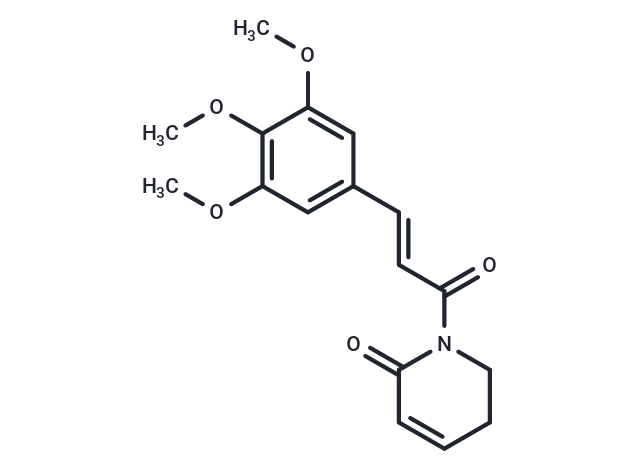Shopping Cart
- Remove All
 Your shopping cart is currently empty
Your shopping cart is currently empty

Piperlongumine (Piplartine) is a natural alkaloid from Piper longum L. It selectively kills cancer cells and strengthens the level of reactive oxygen species (ROS).

| Pack Size | Price | Availability | Quantity |
|---|---|---|---|
| 10 mg | $30 | In Stock | |
| 25 mg | $50 | In Stock | |
| 50 mg | $80 | In Stock | |
| 100 mg | $122 | In Stock | |
| 1 mL x 10 mM (in DMSO) | $30 | In Stock |
| Description | Piperlongumine (Piplartine) is a natural alkaloid from Piper longum L. It selectively kills cancer cells and strengthens the level of reactive oxygen species (ROS). |
| In vitro | Piperlongumine is a known ROS inducer which could induce pancreatic cancer cell death in cell culture[1] As a thromboxane A(2) receptor antagonist, Piperlongumine inhibits platelet aggregation. [2] Piperlongumine also promotes autophagy via inhibition of Akt/mTOR signalling and mediates cancer cell death. [3] |
| In vivo | Piperlongumine (50 mg/kg i.p.) causes in vivo growth inhibition of tumor cells without leading to major changes in the biochemical, hematological and histopathological parameters. [4] |
| Kinase Assay | MEK Kinase Assay: Kinase inactive murine ERK2 (mERK2) K52A/T183A is affinity purified from Escherichia coli expressed using the pET21a vector. MEK1 kinase activity is determined using mERK2 K52A T183A as the substrate. Recombinant MEK1 enzyme (5 nM) is first activated by 0.02 unit or 1.5 nM of RAF1 in the presence of 25 mM HEPES (pH 7.8), 1 mM MgCl2, 50 mM NaCl, 0.2 mM EDTA, and 50 μM ATP for 30 minutes at 25 °C. The reactions are initiated by adding 2 μM of mERK2K52A T183A and 2.5 μCi [γ-33P] ATP in a total volume of 20 μL. The MEK2 kinase activity is determined similarly except that activation by RAF1 is not needed and 11 nM of MEK2 enzyme (active) are used in the assays.Kinase profiling is performed by Invitrogen using their Select Screen Kinase Profiling Service. The Z'-LYTE biochemical assay is used. RDEA119 is assayed in quadruplicate at 10 μM against 205 kinases. |
| Cell Research | MCF-7 and 786-O cells are incubated with various PL concentrations for 48h. Cell proliferation is analysed by CellTiter Blue assay. Effective doses (ED) are calculated using XLift, Microsoft Excel add-in. (Only for Reference) |
| Alias | PPLGM, Piplartine |
| Molecular Weight | 317.34 |
| Formula | C17H19NO5 |
| Cas No. | 20069-09-4 |
| Smiles | COc1cc(\C=C\C(=O)N2CCC=CC2=O)cc(OC)c1OC |
| Relative Density. | 1.223g/cm3 |
| Storage | Powder: -20°C for 3 years | In solvent: -80°C for 1 year | Shipping with blue ice. | ||||||||||||||||||||||||||||||
| Solubility Information | DMSO: 16.67 mg/mL (52.52 mM), Sonication is recommended. | ||||||||||||||||||||||||||||||
Solution Preparation Table | |||||||||||||||||||||||||||||||
DMSO
| |||||||||||||||||||||||||||||||

Copyright © 2015-2024 TargetMol Chemicals Inc. All Rights Reserved.